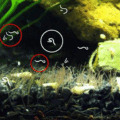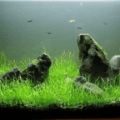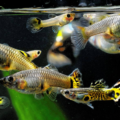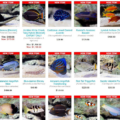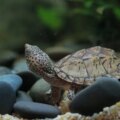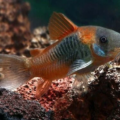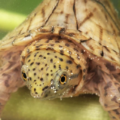Expert tips for keeping the endangered Spotted Turtle in a home aquarium or outdoor pond. Including identification, tank setup, healthcare, special breeding instructions, and much more!
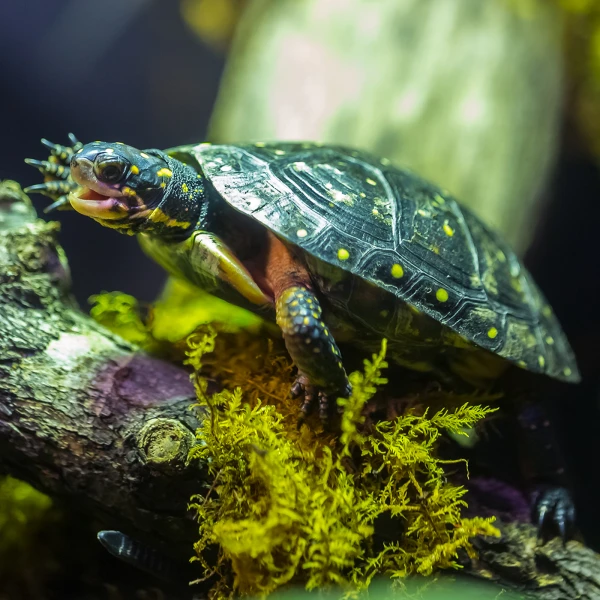
Introduction
Have you ever seen a small, semi-aquatic turtle with an unusual black shell peppered with yellow dots? That’s the North American Clemmys guttata, popularly called the Spotted Turtle.
This small North American turtle, with its rare coloration and calm temperament, is fast becoming a popular choice for experienced turtle keepers. If this is your first time reading a Spotted Turtle profile, that’s fine, everything is included in this guide.
The Spotted Turtle is an endangered species, so it’s best to leave Clemmys guttata turtle care to experienced turtle keepers.
Author’s Note: Check out our post The 14 Types of Freshwater Turtles for even more great semi-aquatic pets!
Creating the Ideal Environment for a Spotted Turtle
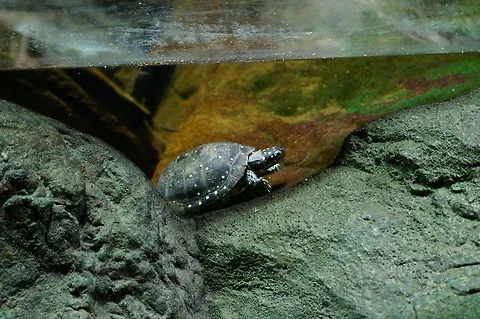
We’re building a semi-aquatic turtle tank with shallow water areas for swimming and a heated dry zone for basking. We emphasize naturalistic features and stable environmental parameters.
Tank Size
We’re starting our Spotted Turtle enclosure setup by choosing the right tank size. A minimum of 40 gallons with land-to-water access gives your 3.5 – 5.5 inch pet turtle a comfortable living space.
Basking Zone
Spotted Turtles enjoy basking, so provide a secured dry basking platform with ample space for this activity. Add a 5.00 – 10.00 UVB lighting and heat lamp to produce 85-90 degrees F heat.
Substrate and Decor
In a Spotted Turtle’s natural environment, grass and leaves are often present, so for a natural look, include moss, sand, leaf litter, and driftwood in your Clemmys guttata habitat design.
Water Parameters
Don’t let your substrate and decor stop you from periodic water cleaning. Keep the conditions stable and dechlorinated at a stable temperature using a moderate filtration system.
| Temperature | 75 – 82°F Water | 80 – 85°F Basking Area |
| Condition | Dechlorinated |
| PH | 6.0 – 8.0 |
| Depth | 18 – 22 inches deep |
Author’s Note: Knowing Why your turtle tank water turns green? (Cause & Fixes) will be useful in the upkeep of your turtle’s enclosure.
Understanding the Behavior of Clemmys guttata
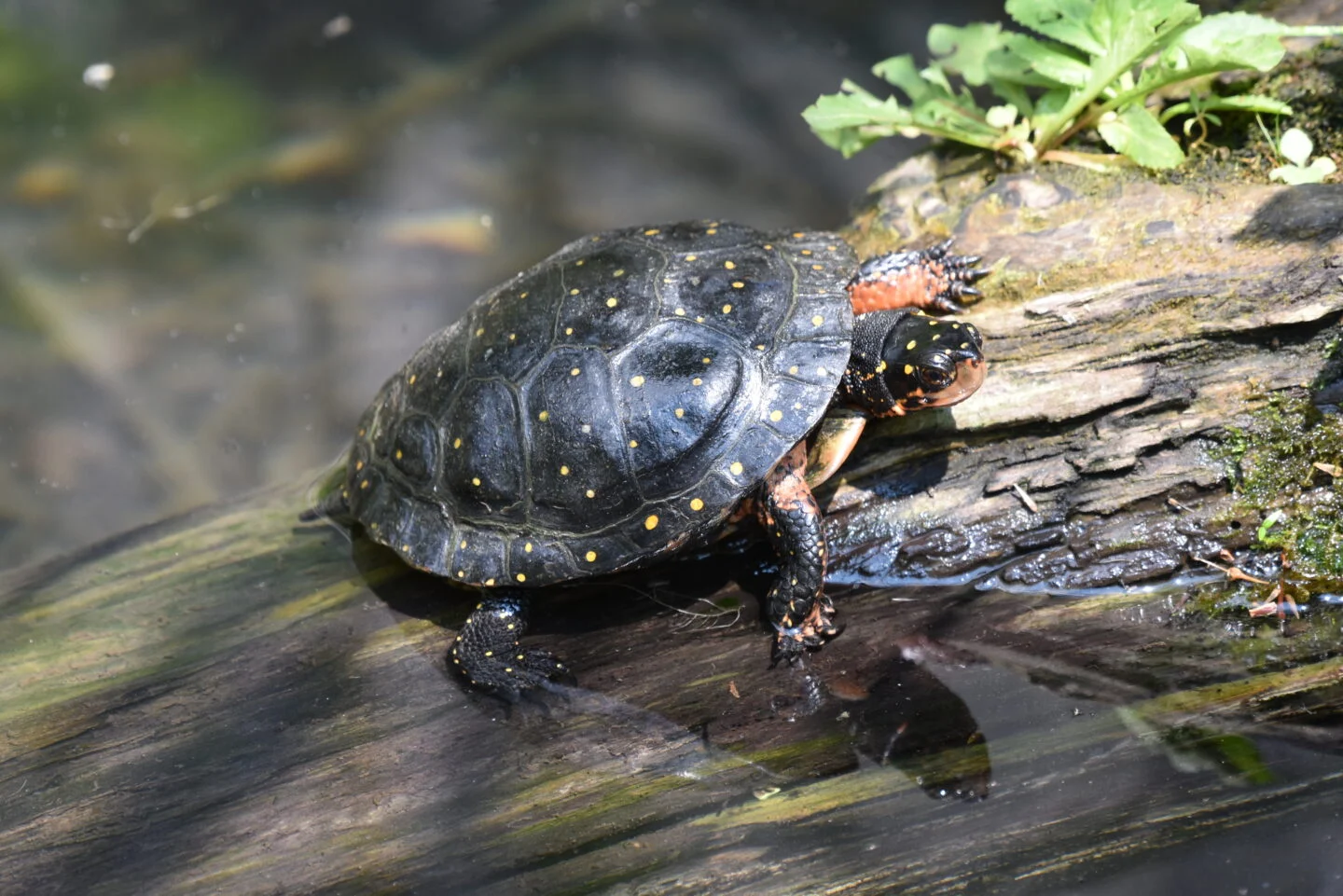
Take note of these Spotted Turtle behavior patterns if you want to keep them in an outdoor pond or indoor aquarium.
- Frequent Basking: They enjoy sunlight, so provide a suitable alternative by using a heat lamp and a firm basking area.
- Exploration: Add beautiful aquatic plants and decor to their habitat to encourage interactive exploration.
- Shyness: As a shy turtle species, give Spotted Turtles caves to hide when they don’t feel like socializing.
- Calmness: Managing a Clemmys guttata’s activity level as a calm species is easy. They only get aggressive around incompatible tank mates.
Author’s Note: Check out the 8 Best Toys for Pet Turtles to Play With for more ways you can interact with and stimulate your pet turtle.
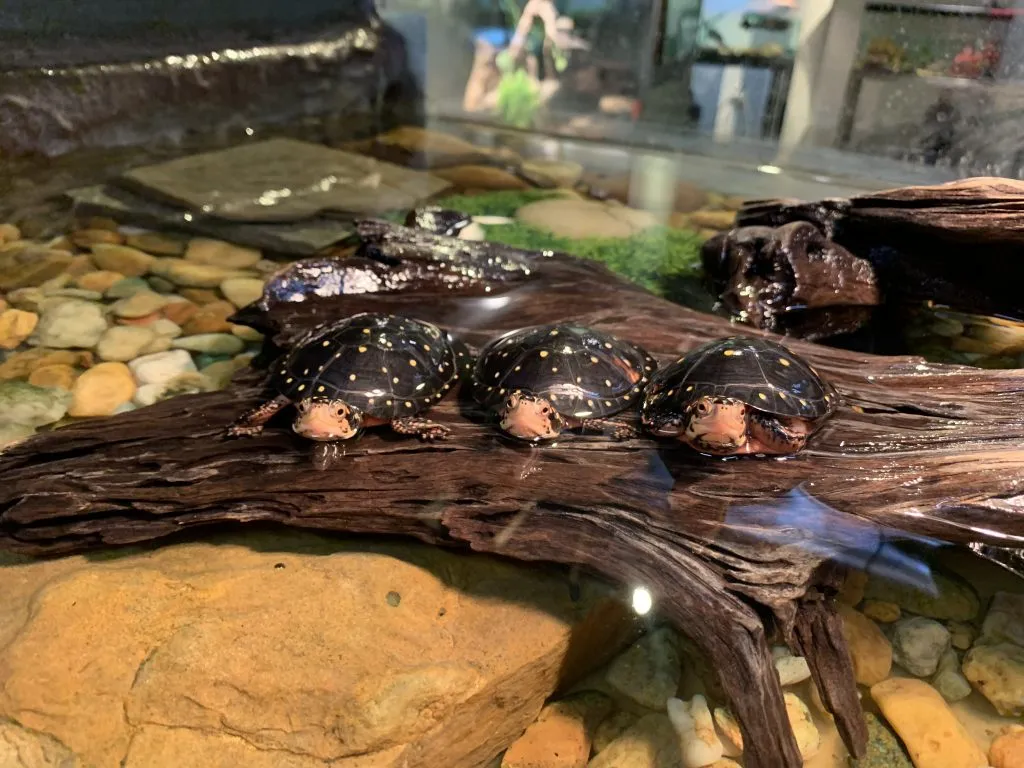
Peaceful turtle cohabitation happens only with other compatible species in well-monitored enclosures.
Suitable Companions
Suitable Spotted Turtle tank mates include Aquatic snails like Ramshorn and Mystery species, small peaceful fish not tiny ones that can easily become food or females of the same species.
If you have time for careful monitoring, you can add similar-sized turtles like Eastern Mud, Stinkpot Musk, and Eastern Painted Turtles.
Tankmates to Avoid
Strictly avoid aggressive turtles like Red-Eared Sliders and Diamondback Terrapins turtles, Softshell Turtles, as well as aggressive fish like Cichlids.
Compatible species will become incompatible in cramped setups, so ensure there’s ample space for cohabitation.
Test your Clemmys guttata compatibility with other species by checking their environmental needs, diet type, temperament, and size.
What to Feed a Spotted Turtle: Building a Balanced Diet
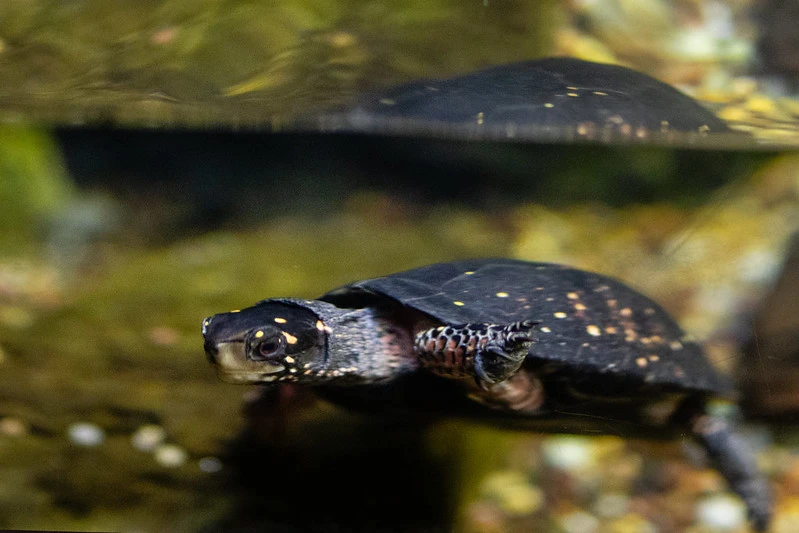
This species survives on an omnivorous turtle diet filled with vegetation and protein sources. In this Clemmys guttata feeding guide, you’ll learn to balance a variety of food sources and supplementation for developing your pet’s immune and shell health.
Diet Recommendations
Use this Spotted Turtle diet plan for the best results:
| Food Source/Type | Options |
| Protein | Earthworms, snails, insects |
| Aquatic Vegetation | Anachris, Watwr Lettuce, Duckweed |
| Commercial Pellets | Sinking Carnivore Pellets, Juvenile Turtle Sticks |
| Supplements | Fruits, Calcium |
Author’s Note: Check out our Complete Guide To Turtle Food: What To Feed And Why It Matters for detailed food recommendations!
Feeding Schedule
Spotted Turtles only feed underwater, so ensure all food types sink to the bottom. Feed the juveniles and hatchlings daily, while adults can eat every other day 3–4 times weekly.
Author’s Note: If you are struggling with a turtle that just won’t eat check out our post on the 8 Reasons Why Your Turtle Won’t Eat (Tips & Fixes) for causes and fixes.
Supplements
Add Calcium sources like cuttlebone and powder with occasional multivitamins as food supplements for healthy shells and stronger immunity.
Breeding and Reproduction in Spotted Turtles
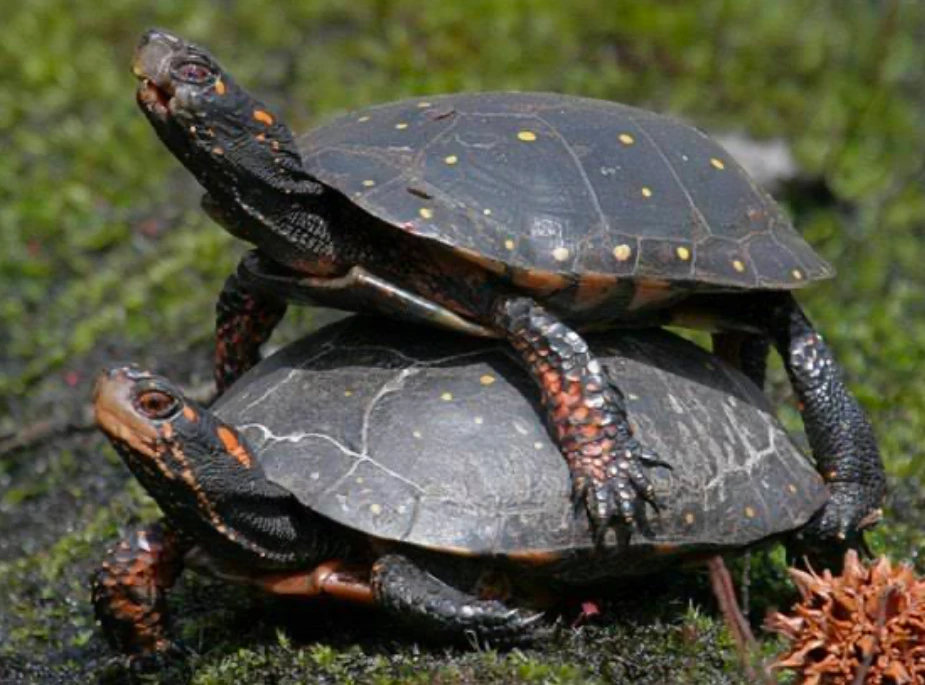
Spotted Turtle breeding happens in the Spring, from typical turtle courtship to rare egg-laying habits and hatchling care. Keep reading for details on achieving a successful Clemmys guttata reproduction.
Mating Behavior
This species typically chooses its mates in the early Spring and starts shallow-water courtship and mating in the early Summer. The male seduces the female with a caress using its front claw. She may accept or refuse by swimming underwater to allow mating or become aggressive.
Egg Laying
If she accepts, after mating, the female Spotted Turtle will lay a pair or trio of 3-5 eggs per clutch in a moist nesting area. Fill the nesting box with damp sandy soil substrate about 12 inches thick.
Incubation & Hatchlings

A Spotted Turtle hatchling incubation period lasts 60 to 80 days, after which you must care for the juveniles.
Feed the juveniles with more protein than veggies to help their development.
Change their water daily to keep it free from germs and disease-causing organisms.
Health Maintenance and Common Issues to Watch For
Follow the instructions in this guide to avoid common Spotted Turtle health problems such as shell rot, respiratory infections, or parasitic concerns. Here’s a recap of those Clemmys guttata care tips, including cleaning and nutritious diets with symptoms to identify illnesses.
Preventative Care
Use a high-quality filter to keep the water clean and reduce the risk of bacterial or fish growth. Grant easy access to the basking platform with a secure ramp for adequate heat exposure and feed your Spotted Turtles with proper nutrition.
Warning Signs
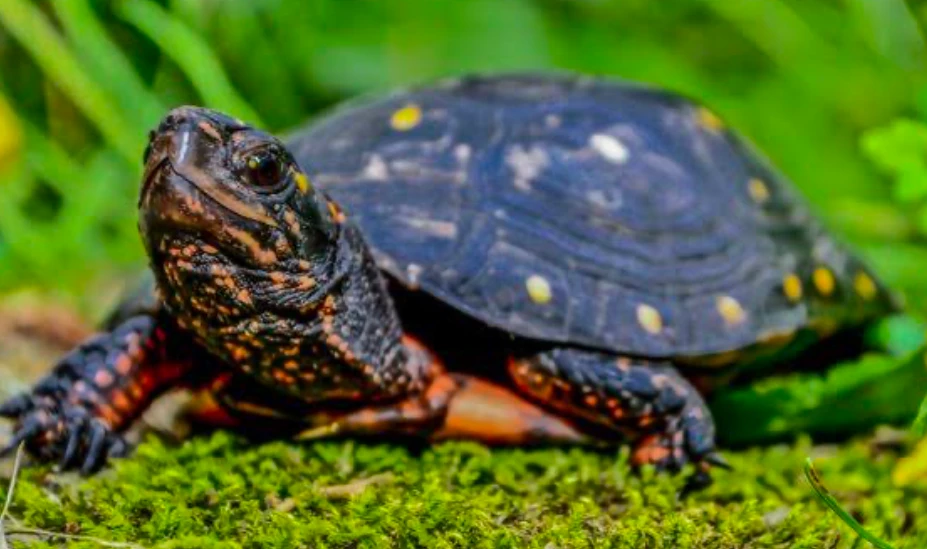
Look out for these freshwater turtle illness signs:
- Lethargy
- Swollen eyes
- Discoloration
- Shell softness
Quarantine affected fish and treat them with the appropriate antibiotics, adjusted diet, water change, or antibacterial cream, depending on the illness cause. Water changes, dietary adjustments, and removal of troublesome companions are first aid treatments.
If symptoms persist, visit a turtle vet for further treatment.
Lifespan and Long-Term Care Commitment
Spotted Turtles can live for 25–50 years, depending on how well you care for them. They need consistent long-term care and not one-off fixes if you want to extend your Spotted Turtle’s lifespan.
Growth Consideration
Because of their size differences, juveniles need different tank setups than adults. So, upgrade your enclosure as it grows.
Lifespan Planning
Long-term care for turtles includes basic steps like providing durable, breathable enclosures with efficient ecosystems for your pet’s new home.
Legal Note
Check regional laws to determine the legal status and requirements for Clemmys guttata pet ownership since they are an endangered species.
Conclusion
Here’s one last look at this Spotted Turtle care summary to help you give your pets the best life.
Although this small and calm species with its beautiful markings is hardy and adaptable, it needs your long-term commitment to its specific needs. That’s why Spotted Turtles are the best turtles for experienced keepers.
Scroll up for details on responsible Clemmys guttata ownership, and let’s hear your thoughts in the comment box below.

